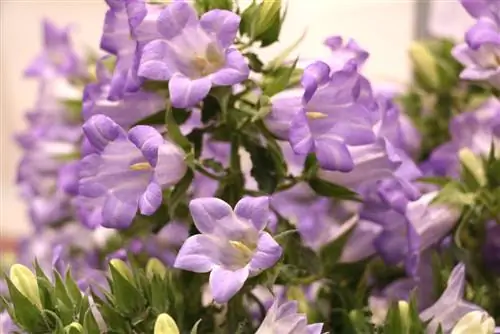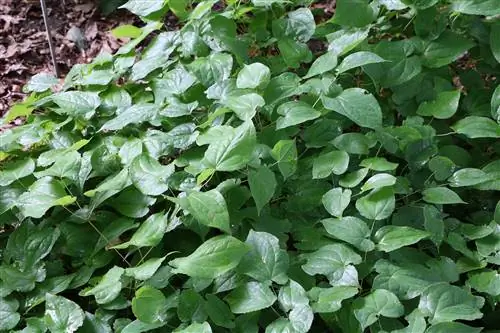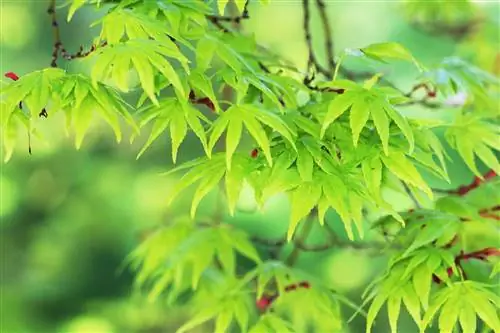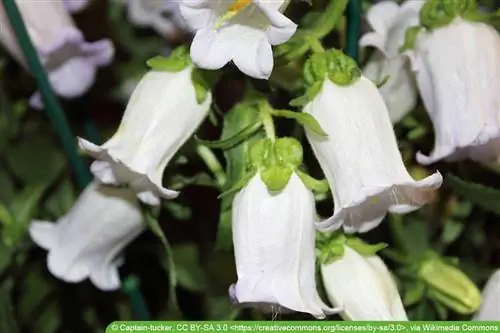- Author admin [email protected].
- Public 2023-12-17 03:39.
- Last modified 2025-01-24 12:45.
On the terrace, on the balcony or on the windowsill - Campanula has few demands on the location. It has a reputation among hobby gardeners as an extremely easy-care plant. But anyone who believes that care is a sure-fire success is wrong. Even tolerant flowers such as the perennial bellsinias only delight with their beautiful blooms every year under optimal conditions.
Short profile
- Plant family: Bellflower family (Campanuleae)
- Species diversity: around 300 species worldwide
- of which native: 20 to 30 species
- natural habitat: Mediterranean to the Caucasus
- Growth height: depending on species, average 15 to 40 cm
- Growth habit: herbaceous
- perennial?: yes
- Flowering period: June to September
- Flower color: light blue (also available in red, yellow, white or violet through breeding)
- Flower shape: star or bell-shaped
- Use: in beds, hanging baskets, rock gardens, (balcony) pots, as a houseplant
Care instructions
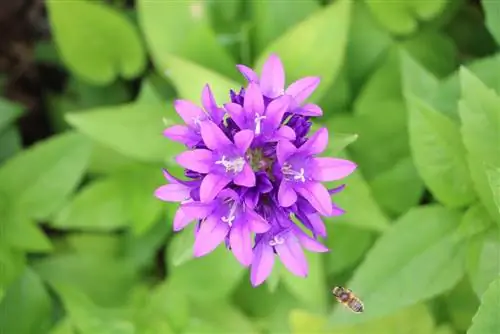
With the right care, the bellflower lives longer and blooms reliably.
Location requirements
The bellflower is suitable both as a decorative bedding plant and for indoor use. In the garden it feels comfortable in a sunny to semi-shady location, although the exact intensity of sunlight varies from species to species.
Note:
Up to 300 different varieties, including many cultivars, not only enable the gardener to create eye-catching color contrasts or a harmonious picture with the rest of the bed planting with the flower color of the bellsinias, depending on their wishes. Thanks to slightly different light requirements, he can adapt the location conditions of the flower ideally to the conditions in his garden.
Houseplants are best placed on the windowsill because they have enough light here. However, it is important to note that they do not receive direct sunlight. The intense midday sun causes the leaves to burn. In addition, the windowsill should not be located directly above a heater.
Substrate
- moist earth
- poor clay
- humos
- loose soil
The bellflower is already happy with commercially available potting soil. However, it is essential to ensure that the water can drain away. The soil outdoors should therefore not be rooted, loose and permeable. With potted plants, the gardener has to pay even more attention to drainage.
Conventional clay pots usually have a clay in the bottom through which the irrigation water can drain away. It has proven useful to cover this with a piece of pottery. However, there is a risk that the water will build up in the coaster. In addition, the soil in the bucket becomes compacted over time. A professional drainage provides relief and can be easily made from inexpensive material:
- Use Styrofoam from parcel deliveries or other packaging
- fill at least a tenth of the bucket with it
- only then pour the substrate over it
- alternatively use expanded clay
Note:
Thanks to the Styrofoam layer, even large plant pots remain wonderfully light and can be transported without any effort.
Pouring
From the paragraph above it is clear that bluebells do not tolerate waterlogging. Soil that is too wet causes mold to form on the roots. If the plant is on a saucer in the bucket, the gardener must pour it out regularly. However, the substrate must not dry out completely. The water requirement is increased, especially during the growth and flowering period. Additionally, the recommended watering behavior varies depending on the flower size. The gardener must water taller species more frequently. You can't go wrong with conventional tap water. Even if this has a relatively high lime content, it does not harm the flower.
Plants
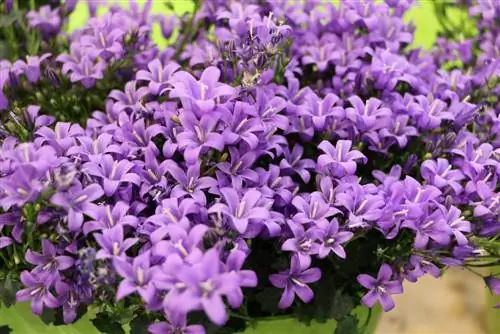
Here you will find all the important information about planting the bellflower (Campanula).
Time
So that the Kaparten bellflower can use the energy available during the growing season, the gardener should plant it in the ground during the warm season. If he plants the plant by the beginning of autumn, it will form a stable root system before it goes into winter dormancy. Young plants take a little longer to grow than pre-grown specimens from specialist retailers. Spring is best for planting here.
Instructions
Since Campanula can be cultivated in many ways thanks to its undemanding nature, the gardener can choose between keeping it outdoors or in a flower pot when planting.
Planting in the bed
- don’t plant until the beginning of April
- Planting distance is half the root width
- Planting depth is around 2 to 3 cm
- Press the surface of the earth lightly
- then keep the substrate moist
Planting in the bucket
- Do not choose a pot that is too small (important for the formation of offshoots)
- Secure tall specimens from breaking with a stick
- otherwise proceed as when planting in the bed
Repotting
Although the bellflower has a rather low, delicate growth compared to other plants, it develops a considerable root system. Especially in the first few years, the pot you initially chose is no longer sufficient and the root mass becomes overwhelming. At this point at the latest, the gardener has to repot the campanula. This is possible throughout the entire growing season from spring to autumn. However, older bluebells have already formed such a stable root system that it is difficult for them to cope with a change of location. Here the gardener should limit repotting to every two to three years.
- the new vessel can be two sizes larger
- fill completely with fresh soil
Fertilizer application
If you would like an even more lush flowering or notice that the bellsiasis is weakening in growth, you can help with commercially available fertilizer. The gardener can also extend the flowering period with special flowering fertilizer. Depending on how the flower absorbs the nutrients, it is given every two to four weeks. However, the gardener does not accelerate the growth of young plants that are still being cultivated in this way. On the contrary, the excess of nutrients damages the delicate plants. In general, it is important to be quantitatively cautious. A dosage that corresponds to half of the package instructions is recommended.
Tip:
The flower can break down complete organic fertilizer independently. In this case, the gardener does not have to worry about overdosing.
Cutting
Pruning is usually not necessary for the delicate bellflower. The gardener should not remove faded flowers simply because of their appearance. Sometimes they still rob the plant of valuable energy. In addition, the flowering period is extended if he picks off all the spent flowers. If a potted plant grows too tall, the gardener proceeds as follows:
- Pruning only from spring to autumn
- remove weak and malformed shoots
- remove cross-growing shoots
Propagate
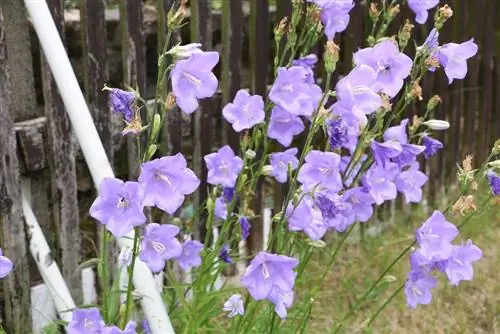
As a rule, the bellflower reproduces independently via its roots. Nevertheless, the gardener can also intervene specifically:
Propagation by sowing
- Start of cultivation: end of February
- Fill the cultivation pot with humus-rich soil (for example conventional potting soil or cactus soil)
- place warm, but not too sunny
- Pour water into the saucer, not directly onto the seedlings
- wait until the shoots are about 3 to 5 cm high
- no fertilizer application
- place in the balcony/flower box after the frost has subsided
Note:
Some types of Carpathian bellflowers are light germinators, others are dark germinators. In the former, the gardener simply places the seeds on the surface of the substrate; the latter is pressed a few centimeters into the soil. In addition, for some varieties it is necessary to stratify the seeds before sowing. To do this, the gardener puts them in the refrigerator for a few days. He is not allowed to store the seeds for a long time because they only have a limited shelf life.
Propagation by cuttings
- Harvest after winter rest
- Length of cuttings: 8 cm
- with 3 to 4 pairs of leaves
- Treat cutting surface with rooting hormone
- Prepare a mixture of sand and peat
- moisten well
- Insert cuttings 1 to 2 cm deep
- cover with plastic bag
- bright location at 20°C
- Root formation occurs after 20 days
- then convert to normal culture
Reproduction by division
- Digging the mother plant out of the ground
- Divide root balls
- tamp old soil well
- place in fresh soil
Note:
Division is only possible if the root ball is not too woody.
Wintering
The bellflower slows down its growth slightly in winter to recover from the growing season. However, it is not winter-proof and requires a frost-free winter quarters. You should get this after the last flowering in autumn. The following conditions apply here:
- cool (around 10°C)
- dark
- low humidity protects against pests
- reduced watering (only every two weeks)
Note:
If the Carpathian bellflower is exposed to high temperatures in its winter quarters, it will sprout early and then die.
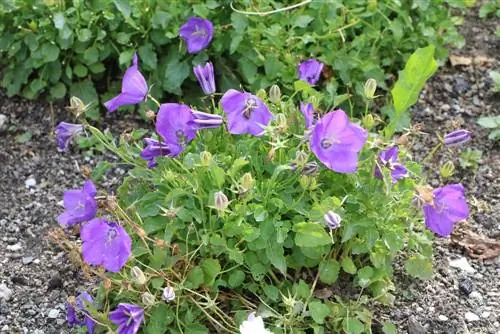
If it is not possible to overwinter the campanula indoors, insulation made of raffia or jute and a layer of mulch made of fir or spruce branches protect it from the cold.
Diseases and pests
Small errors in care, such as incorrect watering behavior, can cause disease. The most common pests include:
- the mosaic virus (yellow stripes, zigzag lines or ring-shaped structures on the leaves)
- Spider mites (cobweb-like threads on the plant)
- Thrips (yellow-silvery speckles on the leaves)
Most of the time, simple home remedies such as home-made plant-based sprays help against the pests. If the infestation is severe, the gardener can also use a product from a specialist retailer, as long as it is free of chemical substances.

